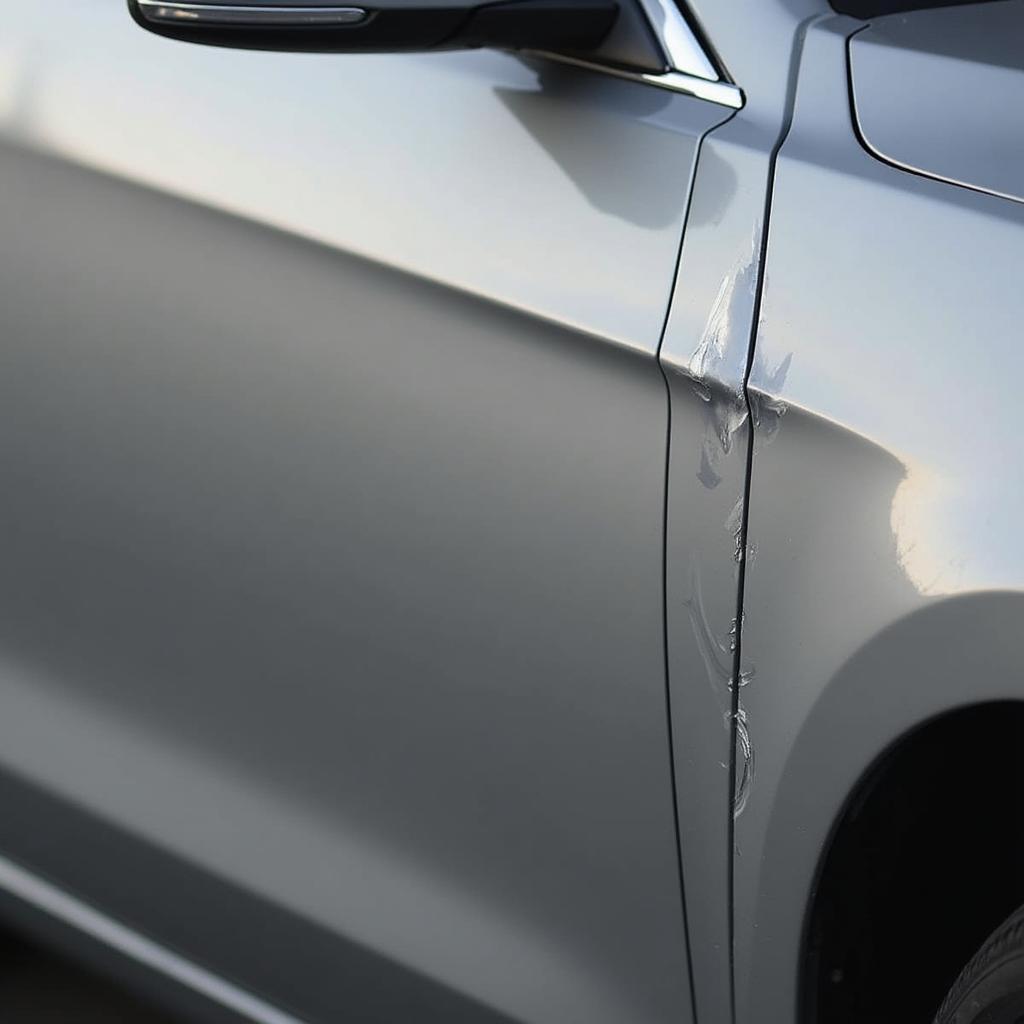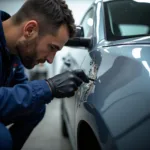Discovering a dent with paint damage on your car can be disheartening. It’s not just a cosmetic issue, but one that can lead to rust and further damage if left unaddressed. Fortunately, you don’t always need a costly trip to the auto body shop. This guide will walk you through the steps on how to repair dent with paint damage on your car, empowering you to tackle the issue head-on.
Assessing the Damage: When DIY is Possible
Before diving into the repair process, it’s crucial to evaluate the severity of the damage. Minor dents and paint scratches often lend themselves well to DIY fixes, saving you time and money.
- Small Dents: If the dent is shallow and the paint is only slightly scratched, you can likely address it yourself using the methods outlined in this guide.
- Paint Chips: For minor paint chips, touch-up paint and a clear coat can work wonders.
Essential Tools and Materials
Gathering the right tools and materials is key to a successful dent and paint repair. Here’s a checklist:
- Cleaning Supplies: Car wash soap, microfiber cloths, rubbing alcohol
- Dent Repair Kit: (for smaller dents) – these often include a suction cup dent puller and plastic scraping tools
- Body Filler: (for larger dents) – choose a quality product suitable for automotive use
- Sandpaper: Assorted grits (e.g., 180, 320, 400, 600)
- Primer: Matching your car’s paint color
- Automotive Paint: Matching your car’s paint code
- Clear Coat: For a protective and glossy finish
- Masking Tape and Paper: To protect surrounding areas
- Personal Protective Equipment: Gloves and safety glasses
Step-by-Step Dent and Paint Repair Guide
Follow these steps to repair a dent with paint damage on your car:
- Clean the Area: Thoroughly wash the damaged area with car wash soap and water. Allow it to dry completely.
- Dent Repair:
- Small Dents: Use a dent repair kit according to the manufacturer’s instructions. These kits often utilize suction to pull out minor dents.
- Larger Dents: You’ll need to apply body filler. Start by sanding the area around the dent to create a smooth surface for the filler to adhere to. Mix the body filler as directed and apply it in thin layers, allowing each layer to dry before sanding and applying the next.
- Sanding: Once the dent is level, use progressively finer grits of sandpaper to smooth out the area. Start with a coarser grit (around 180) and work your way up to a finer grit (around 600) to achieve a seamless finish.
- Priming: Apply several thin coats of primer to the repaired area, allowing each coat to dry before applying the next. This helps to create an even surface for the paint to adhere to.
- Painting: Shake your automotive paint can well and apply several thin coats to the primed area. Maintain a consistent distance from the surface and use even strokes to avoid runs or drips.
- Clear Coat Application: Once the paint is dry, apply a few thin layers of clear coat to protect the paint and provide a glossy finish.
- Final Touches: Allow the clear coat to dry completely, then use a rubbing compound and a polishing pad to buff out any imperfections and blend the repaired area with the surrounding paint.
When to Call a Professional
While DIY repairs can be effective for minor damage, there are instances when it’s best to consult a professional.
- Extensive Damage: If you’re dealing with large dents, deep scratches that expose metal, or damage to structural components, it’s best to leave it to the experts.
- Safety Concerns: If the damage is near critical areas like headlights, airbags, or sensors, professional repair is essential.
Preventing Future Damage
Prevention is key! Here are some tips to protect your car’s paint:
- Regular Washing: Frequent washing removes dirt and grime that can scratch the paint.
- Waxing: Apply a protective layer of wax every few months.
- Covered Parking: Whenever possible, park in a garage or under a carport to shield your car from the elements and potential door dings.
FAQs about Car Dent and Paint Repair
Q: Can I use household paint for touch-ups?
A: No, household paint is not designed for automotive use and will not adhere properly or withstand the elements. Always use automotive touch-up paint that matches your car’s paint code.
Q: How long does it take for body filler to dry?
A: Body filler typically dries to the touch within 30 minutes, but it’s crucial to allow ample drying time (as specified by the manufacturer) before sanding and painting for optimal results.
Q: Can I repair a dent with paint damage on my car’s plastic bumper?
A: While some of the same principles apply, repairing plastic bumpers often requires specialized tools and techniques. If you’re unsure, it’s best to consult a professional.
Need More Help?
Fixing a dent with paint damage on your car can be a rewarding DIY project, but it requires careful attention to detail. For more in-depth guides on car repairs, check out these resources:
If you’re dealing with more extensive damage or are uncomfortable tackling the repair yourself, don’t hesitate to contact a trusted auto body shop for professional assistance.



